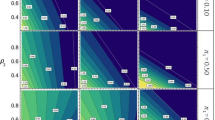Abstract
MANY animals and most higher plants are hermaphrodites. The basic argument of this paper is that the sex habit of a species is determined by selection acting on the number of offspring produced by individuals of different types. The argument differs radically from most earlier explanations of the evolution of hermaphroditism (reviewed by Ghiselin)1,2, although it is formally similar to a recent explanation3 of sequential hermaphroditism, in which individuals function first as one sex and then the other.
Similar content being viewed by others
References
Ghiselin, M. T., Q. Rev. Biol., 47, 189–208 (1969).
Ghiselin, M. T., The Economy of Nature and the Evolution of Sex (University of California Press, Berkeley, 1974).
Leigh, E. G., Charnov, E. L., and Warner, R. R., Proc. natn. acad. Sci. U.S.A., (in the press).
Maynard Smith, J., and Price, G. R., Nature, 246, 15–18 (1973).
Fisher, R. A., The Genetical Theory of Natural Selection (Oxford University Press, Oxford, 1929).
MacArthur, R. H., in Theoretical and Mathematical Biology (edit. by Waterman, T., and Morwitz, H.) (Blaisdell, Lexington, 1965).
Maynard Smith, J., in Group Selection (edit. by Williams, G. C.), 163–175 (Aldine, Chicago, 1971).
Lewis, D., New Phytol., 40, 56–63 (1951).
Lloyd, D. G., Genetics, 45, 325–339 (1975); Heredity, 32, 11–34 (1974); Heredity, 32, 35–44 (1974).
Arroyo, M. T. K., and Raven, P. H., Evolution, 29, 500–511 (1975).
Grant, V., Genetics of Flowering Plants (Columbia University Press, New York, 1975).
Baker, H. G., Cold Spring Harb. Symp. quant. Biol, 24, 177–191 (1959).
Author information
Authors and Affiliations
Rights and permissions
About this article
Cite this article
CHARNOV, E., BULL, J. & MAYNARD SMITH, J. Why be an hermaphrodite?. Nature 263, 125–126 (1976). https://doi.org/10.1038/263125a0
Received:
Accepted:
Issue Date:
DOI: https://doi.org/10.1038/263125a0
- Springer Nature Limited
This article is cited by
-
Pollination inaccuracy: estimating male fitness in the movement-assisted dichogamous species Clerodendrum infortunatum
Evolutionary Ecology (2023)
-
A model for evolutionary rescue through plant mating system
Evolutionary Ecology (2023)
-
Mating behavior and reproductive morphology predict macroevolution of sex allocation in hermaphroditic flatworms
BMC Biology (2022)
-
Selection drives convergent gene expression changes during transitions to co-sexuality in haploid sexual systems
Nature Ecology & Evolution (2022)
-
Egg-trading worms start reciprocation with caution, respond with confidence and care about partners’ quality
Scientific Reports (2021)





